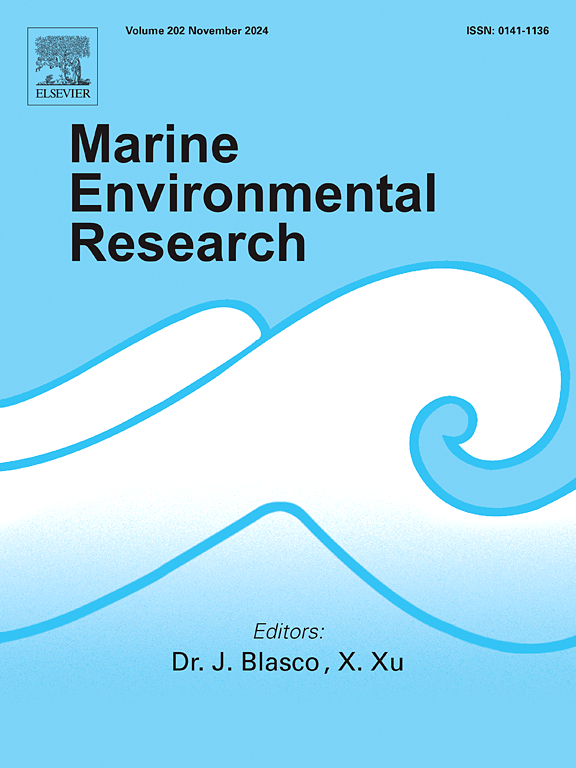The temperate seagrass species Cymodocea nodosa and the associated bacteria co-response to sunscreen pollution
IF 3
3区 环境科学与生态学
Q2 ENVIRONMENTAL SCIENCES
引用次数: 0
Abstract
Sunscreens are included among the contaminants of emerging concern (CECs) as their production and use have spread over years while damaging aquatic biota. Sunscreens can damage the photosynthetic systems and change the microbiome of seagrasses, triggering alterations in carbon metabolism –including primary production and dissolved organic carbon (DOC) fluxes– and ecological functions. Here, we conducted a 31-day mesocosm experiment exposing Cymodocea nodosa plants to a mixture of commercial sunscreens. Sunscreens produced a significant reduction on net production rates, switching the system from autotrophic to heterotrophic, which was ascribable to an increase in heterotrophic bacteria families (some known to degrade complex substrates) and, more importantly, to a significant reduction of photosynthetic pigments in plants. Moreover, a significant release of DOC at night attributed to exudation from disrupted roots was recorded, which accounted for the observed increase in bacteria abundance and family richness recorded in the phyllosphere. A higher accumulation of starch in rhizomes suggests a certain degree of resistance of this species. However, we observed a trend to reduce some protective bacteria taxa, whereas promoted the growth of other pathogenic ones for seagrasses, along with other taxa related with the consumption of plant-derived polysaccharides and lignin compounds. Therefore, our results indicated that this CEC may reduce the contribution of seagrasses to the blue carbon pool, among others ecosystem services, and suggest a possible prompt of seagrass diseases if stressing conditions are maintained over time.

温带海草物种Cymodocea nodosa及其相关细菌对防晒霜污染的共同反应
由于防晒霜的生产和使用多年来不断蔓延,同时破坏了水生生物群,因此防晒霜被列入了新兴关注的污染物(CECs)之列。防晒霜会破坏光合系统,改变海草的微生物群,引发碳代谢(包括初级生产和溶解有机碳(DOC)通量)和生态功能的改变。在这里,我们进行了一项为期31天的中生态实验,将石竹植物暴露于商业防晒霜的混合物中。防晒霜显著降低了净产量,将系统从自养转变为异养,这可归因于异养细菌家族的增加(其中一些已知可降解复杂底物),更重要的是,植物中光合色素的显著减少。此外,由于被破坏的根渗出物,DOC在夜间大量释放,这也解释了在根层圈中观察到的细菌丰度和科丰度的增加。根状茎中淀粉的积累较高,表明该物种具有一定程度的抗性。然而,我们观察到一些保护菌群有减少的趋势,而促进了海草的其他致病菌群的生长,以及其他与植物源性多糖和木质素化合物消耗相关的分类群。因此,我们的研究结果表明,这种CEC可能会减少海草对蓝色碳库的贡献,以及其他生态系统服务,并提示如果胁迫条件长期维持,海草疾病可能会发生。
本文章由计算机程序翻译,如有差异,请以英文原文为准。
求助全文
约1分钟内获得全文
求助全文
来源期刊

Marine environmental research
环境科学-毒理学
CiteScore
5.90
自引率
3.00%
发文量
217
审稿时长
46 days
期刊介绍:
Marine Environmental Research publishes original research papers on chemical, physical, and biological interactions in the oceans and coastal waters. The journal serves as a forum for new information on biology, chemistry, and toxicology and syntheses that advance understanding of marine environmental processes.
Submission of multidisciplinary studies is encouraged. Studies that utilize experimental approaches to clarify the roles of anthropogenic and natural causes of changes in marine ecosystems are especially welcome, as are those studies that represent new developments of a theoretical or conceptual aspect of marine science. All papers published in this journal are reviewed by qualified peers prior to acceptance and publication. Examples of topics considered to be appropriate for the journal include, but are not limited to, the following:
– The extent, persistence, and consequences of change and the recovery from such change in natural marine systems
– The biochemical, physiological, and ecological consequences of contaminants to marine organisms and ecosystems
– The biogeochemistry of naturally occurring and anthropogenic substances
– Models that describe and predict the above processes
– Monitoring studies, to the extent that their results provide new information on functional processes
– Methodological papers describing improved quantitative techniques for the marine sciences.
 求助内容:
求助内容: 应助结果提醒方式:
应助结果提醒方式:


